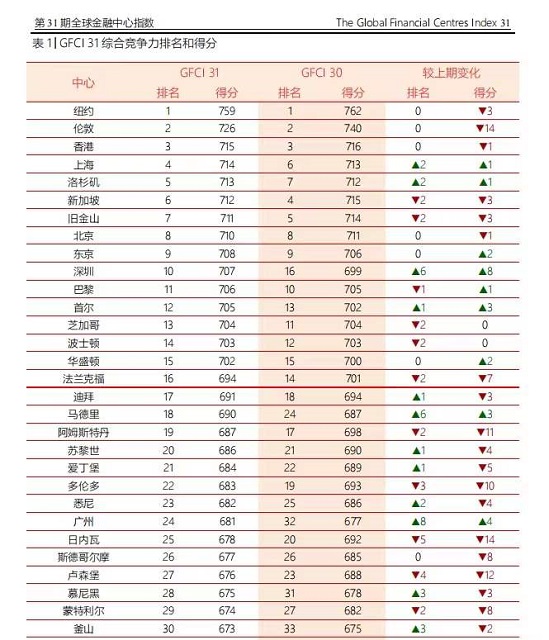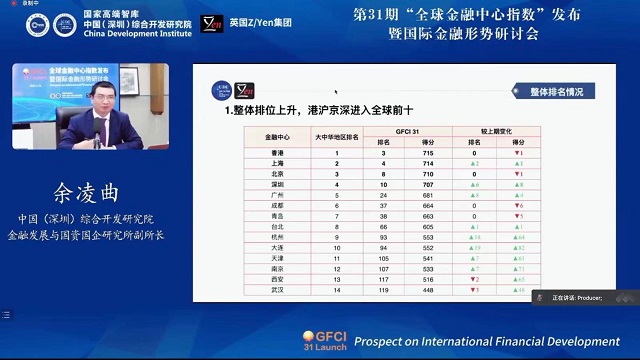The latest ranking of global financial centers: Shanghai ranks fourth, and Shenzhen ranks among the top ten.
Shanghai’s ranking in the global financial center is 2 places higher than the previous period, ranking fourth, and its comprehensive competitiveness score is also increased by 1 point.
On March 24th, the 31st Global Financial Center Index Report (GFCI 31) jointly compiled by China (Shenzhen) Comprehensive Development Research Institute, a national high-end think tank, and Z/Yen Group, a British think tank, was released simultaneously in Shenzhen, China and London, England.
The index evaluates and ranks the world’s major financial centers in terms of business environment, human capital, infrastructure, financial development level and reputation. A total of 119 financial centers entered the list in the 31st GFCI, and the top ten financial centers in the world were ranked as follows: new york, London, Hong Kong, Shanghai, Los Angeles, Singapore, San Francisco, Beijing, Tokyo and Shenzhen.

The index of global financial centers is updated in March and September each year, which has attracted wide attention from the global financial community. In March 2007, Z/Yen Group in London, UK released the first Global Financial Center Index (GFCI 1). In July, 2016, China (Shenzhen) Comprehensive Development Research Institute (CDI) and London Z/Yen Group established a strategic partnership, jointly conducted research on financial centers, and continued to cooperate in compiling the global financial center index.
Shanghai, North China and Shenzhen rank among the top ten global finance.
In this issue, there are 12 financial center cities in GFCI China Mainland, among which Shanghai, Beijing and Shenzhen have all entered the top ten financial centers in the world, 7 financial center cities have improved their rankings, and 3 financial center cities have remained stable.
Among the mainland financial center cities, Shanghai continues to maintain its leading position, ranking two places again, becoming the fourth largest financial center in the world after Hong Kong, and ranking second in financial technology in the world.
Beijing’s score dropped by 1 point, but the global ranking remained eighth, and the ranking of financial technology rose by 2 places, replacing London as the third in the world; Shenzhen is the city with the largest increase in ranking and score of the top ten financial centers, with a gap of only 1 point compared with Tokyo, and its ranking in business environment, human capital, infrastructure, financial industry development level, city reputation and five areas has all increased.
The ranking of Guangzhou financial center has risen by 8 places, and it is currently ranked 24th in the world, and it is advancing towards the top 20 financial centers in the world, and its position as an international financial center is further stabilized. The rankings of Chengdu and Qingdao in GFCI remain unchanged, among which the ranking of financial technology in Chengdu has greatly increased by 16 places, ranking 44th in the world; Hangzhou, Dalian, Tianjin, Nanjing and other financial center cities that entered GFCI later are gradually becoming familiar to global financial practitioners, and their scores are rising rapidly. Among them, Dalian’s score is increased by 82 points, ranking 19 places, and Nanjing’s score is increased by 71 points, ranking 7 places.

Yu Lingqu, deputy director of the Institute of Finance and Modern Industry of China (Shenzhen) Comprehensive Development Research Institute, said that the ranking of financial centers in Greater China has risen overall, and Hong Kong, Shanghai, Beijing and Shenzhen have all entered the top ten. From a global perspective, it presents a pattern of "rising east and descending west". The strength of Hongkong and Shanghai is getting closer and closer to that of new york and London, and the ranking of Shenzhen and Guangzhou is rising rapidly.
Competition among top financial centers is becoming increasingly fierce.
It can also be seen from the ranking of the global financial center index in this issue that the overall score of financial centers has slowed down and the world has accelerated its recovery from the new crown epidemic.
Since the global spread of the COVID-19 epidemic, the overall average score of GFCI has dropped for more than three consecutive periods, of which the 28th period has dropped by more than 40 points, and the scores of more than 80 financial centers around the world have dropped, and then the decline rate has slowed down. The overall average score of this period has dropped by less than 1 point compared with the previous period, and the rankings of financial centers are relatively stable. Among the top 40 financial centers, no financial center has dropped by more than 10 places.
In this ranking, new york, London and Hong Kong once again rank among the top three global financial centers, but their overall scores have declined compared with the previous period, with London having the largest decline, reaching 14 points, while Hong Kong and new york only dropped by 1 point and 3 points respectively, which further widened the gap between London and new york.
At the same time, Shanghai and Los Angeles replaced Singapore and San Francisco respectively, ranking fourth and fifth in the world. After the ranking of Shenzhen dropped to 16th place in the previous period, the score of this period increased by 8 points, and the ranking also increased by 6 places, ranking among the top ten global financial centers again.
Yu Lingqu said that from a global perspective, the pattern of the top financial centers has been very fixed, and the ranking often rises and falls by one or two, but from this period, Shenzhen and Guangzhou have risen by six and eight respectively, which is also very large from a global perspective.
Although the pattern of the world’s top ten financial centers has been basically stable, the rating gap of each financial center is between 1 and 2 from Hong Kong ranked third to Shenzhen ranked tenth. Even a small change in rating can cause huge fluctuations in ranking, and the competition among top financial centers has become increasingly fierce.